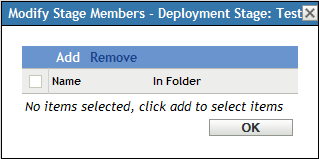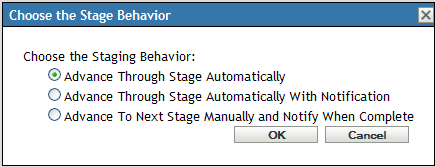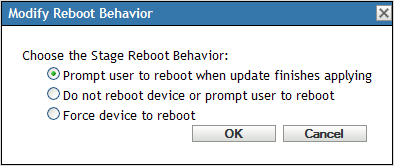20.2 Creating Deployment Stages
Deployment stages are optional; however, stages allow you to deploy an update one step at a time, such as to a test group first, then to your managed devices. If a failure occurs during the update process, the process is halted. E‑mail notifications can let you know when each stage has completed.
The following sections contain more information:
20.2.1 Understanding Stages
You can do the following with stages:
-
Set them up for different devices or groups, such as for a test group, specific devices or device groups, or all managed devices in the zone.
-
Modify an existing stage’s membership.
-
Change the order in which the stages run.
-
Rename and delete stages.
-
Specify the default timeout for a stage. When the timeout value is reached, the stage’s deployment stops and an e-mail message is sent , if e-mail notification is configured. You can cancel the deployment, or you can clear the error to restart the stage and reset the timeout. Or, you can ignore all pending devices to trigger a stage progression (either automatic, or wait for administrator action based on the setting).
-
Specify the reboot behavior when devices complete the update: prompt a reboot, force a reboot, or suppress rebooting.
-
Specify how the update process is to advance through the stages:
-
Automatically, with or without notification
-
One stage at a time with notification when each stage is completed
-
Bypass the configured stages and immediately apply the update to all devices
-
There are many reasons for creating deployment stages:
-
Testing the update on certain devices before deploying it to your production environment
-
Including all Primary Servers in one stage so they can be updated at the same time.
-
Grouping your servers in several stages so that the update process isn’t too intensive for the Primary Server being used to perform the updates.
-
Grouping the workstations in several stages so that the update process isn’t too intensive for the Primary Server being used to perform the updates.
Any managed devices that are not part of a stage are automatically updated after the last deployment stage has been processed.
You cannot configure stages when an update is in progress.
The following figure illustrates the Deployment Stages panel on the System Updates page:
Figure 20-1 The Deployment Stages Panel

The following table explains the column information. For some columns, you can sort the listed information by clicking a column heading. Click it again to reverse the sorting order.
Table 20-1 Deployment Stages column descriptions.
|
Column Heading |
Explanation |
|---|---|
|
|
Displays the order in which the stages run. You can rearrange the staging order by using the and options. For more information, see Rearranging the Order in Which Stages Start. The first stage listed always displays ordinal 1, the second, ordinal 2, and so on. Therefore, you do not need to include a sequence number in your stage names. |
|
|
Name of the stage, which you specify when creating the stage by using the > option. Make this name descriptive enough to indicate its purpose. |
|
|
This column contains the option, which opens the Modify Stage Members dialog box that lists all of the members of the stage. You can use the dialog box to add or remove members from the stage. Stage membership can include individual devices and groups that contain devices. For more information, see Modifying the Membership of a Deployment Stage. |
|
|
Displays the current behavior for each stage, which you can change by using the > option. For more information, see Modifying Staging Behavior. |
|
|
Displays the reboot behavior of devices after the update is deployed. Some updates do not require a device to be rebooted after they have been deployed to a device. However, if a reboot is required to complete the update process, the deployment is not completed until the device is rebooted. You have the following reboot options:
For more information, see Modifying Reboot Behavior. |
|
|
Displays the stage timeout, listed in minutes, which you can change by using the > option. The default is 3 days, 0 hours, and 0 minutes, which is the global timeout value that can be changed in Stage Timeout Settings. Changing the value here only changes it for the selected deployment stage. When the timeout value is reached, the stage’s deployment stops and an e-mail message is sent, if e-mail notification is configured. You can cancel the deployment, or you can clear the error to restart the stage and reset the timeout. Or, you can ignore all pending devices to trigger a stage progression (either automatic, or wait for administrator action based on the setting). For more information, see Modifying the Stage Timeout. |
20.2.2 Creating and Populating a Deployment Stage
-
In ZENworks Control Center, click in the left pane, then click the tab.

-
In the Deployment Stages panel, click , then select .
You cannot add a stage while a deployment is in process.
-
Specify a deployment stage name, then click .
Deployment stages appear as device folders on the tab, so you should specify names that help you to know a folder’s purpose.
You might want to include something like “Deployment Stage” at the beginning of the name to sort the groups in the devices listing in ZENworks Control Center.
For information about naming in ZENworks Control Center, see Section B.0, Naming Conventions in ZENworks Control Center.
A newly created stage does not have any members. You must modify the stage’s membership to add them.
-
Add devices to a deployment stage:
-
In the column, click for the stage for which you want to add members.

-
Click , browse for and select the devices, then click .
You can add individual devices or device groups, or any combination of them.
You can have both managed servers and workstations in the same deployment stage or in different stages, or you can split your servers and workstations into separate deployment stages.
IMPORTANT:Some of your network servers will be Primary Servers for use in ZENworks management, while other servers on your network might only be managed devices with the ZENworks Adaptive Agent installed on them.
You must update your Primary Servers before updating any of the other managed servers and especially before updating any managed workstations.
-
Repeat Step 4.b until you are finished adding members to the stage.
-
To add members to another stage, repeat Step 4.a through Step 4.c.
-
-
Repeat Step 2 through Step 4 until you have created all of your deployment stages.
-
If you need to reorder the sequence of the deployment stages, select a stage, then click or .
If you are using one of the stages for test purposes, make sure that it is first in the listing.
20.2.3 Modifying the Stage Timeout
A stage timeout sets the length of time before a stage terminates. The default timeout is 3 days. You set the value for individual stage timeouts by using the procedure in this section. The global stage timeout value is established by following the steps in Stage Timeout Settings.
You cannot modify a stage if an update is in progress.
To set the timeout value for a selected stage:
-
In ZENworks Control Center, click in the left pane, then click the tab.
-
In the Deployment Stages panel, select the check box for a stage, click , then select to display the following dialog box:

-
Specify the timeout value.
This change in timeout value only applies to the selected stage. If you specify a timeout value for this stage, set its value to be long enough to accommodate updating all of the devices in the stage.
When the timeout value is reached, the stage’s deployment stops and an e-mail message is sent, if e-mail notification is configured. You can cancel the deployment, or you can clear the error to restart the stage and reset the timeout. Or, you can ignore all pending devices to trigger a stage progression (either automatic, or wait for administrator action based on the setting).
-
(Optional) Select the check box to specify using the global timeout value (default of 3 days, 0 hours, and 0 minutes).
For more information, see Stage Timeout Settings.
-
Click .
20.2.4 Modifying Staging Behavior
The default stage behavior is to automatically advance through the configured stages. You can change this default behavior. If you change the staging behavior for one stage, the change becomes effective for all stages.
-
In ZENworks Control Center, click in the left pane, then click the tab.
-
In the Deployment Stages panel, select the check box next to any stage, click , then select to display the following dialog box:

-
Select one of the following stage behaviors:
Advance Through Stages Automatically: As soon as one stage has completed its updates, the next stage begins. This is the default behavior (its check box is enabled).
After the last stage has completed, all applicable devices that are not members of a stage are then processed.
Advance Through Stages Automatically with Notification: Starts the first stage, sends an e‑mail notification when it has completed, then automatically starts the next stage, and so on.
To use this option, a notification method must be set up on the System Update Download Settings page in the section.
Advance to Next Stage Manually and Notify When Complete: Use this method for user action between the stages, such as reviewing the results of an update to a test group.
This option automatically starts the first stage. After any stage has completed, e‑mail notification is sent, then the system waits for you to manually start the next stage.
To use this option, a notification method must be set up on the System Update Download Settings page in the section.
-
Click .
20.2.5 Modifying Reboot Behavior
Some updates do not require a device to be rebooted after they have been deployed to a device. However, if a reboot is required to complete the update process, the deployment is not completed until the device is rebooted.
To modify the reboot behavior:
-
In ZENworks Control Center, click in the left pane, then click the tab.
-
In the Deployment Stages panel, select the check box for one or more the deployment stages, click , then click .

-
Select one of the following options:
-
Prompt User to Reboot When Update Finishes Applying (Default): After the update has been applied, a request to reboot is immediately displayed. If the user initially rejects rebooting, the user is periodically requested to reboot the device, until the device is rebooted.
-
Do Not Reboot Device: The device does not reboot; however, the user is periodically requested to reboot the device, until the device is rebooted.
-
Force Device to Reboot: After the update has been applied, the device is automatically rebooted without user intervention, if a reboot is required by the update.
-
-
Click .
20.2.6 Modifying the Membership of a Deployment Stage
-
In ZENworks Control Center, click in the left pane, then click the tab.
-
(Optional) Add devices to a deployment stage:
-
In the column, click for the stage for which you want to add members.

-
Click , browse for and select the devices, then click .
You can add individual devices or device groups, or any combination of them.
You can have both managed servers and workstations in the same deployment stage or in different stages, or you can split your servers and workstations into separate deployment stages.
IMPORTANT:Some of your network servers will be Primary Servers for use in ZENworks management, while other servers on your network might only be managed devices with the ZENworks Adaptive Agent installed on them.
You must update your Primary Servers before updating any of the other managed servers and especially before updating any managed workstations.
-
Repeat Step 2.b until you are finished adding members to the stage.
-
To add members to another stage, repeat Step 2.a through Step 2.c.
-
-
(Optional) Remove devices from a deployment stage:
-
In the column, click for the stage for which you want to remove members.

-
Select the check box next one or more devices that you want to remove, then click .
-
-
Click when you have finished configuring the stage’s membership.
20.2.7 Renaming a Deployment Stage
-
In ZENworks Control Center, click in the left pane, then click the tab.
-
In the Deployment Stages panel, click the check box for the deployment stage to be renamed.
-
Click .
-
In the Rename dialog box, specify the new name, then click .
For information about naming in ZENworks Control Center, see Section B.0, Naming Conventions in ZENworks Control Center.
20.2.8 Deleting a Deployment Stage
-
In ZENworks Control Center, click in the left pane, then click the tab.
-
In the Deployment Stages panel, click the check box for one or more of the deployment stages to be deleted.
-
Click .
Deleted stages cannot be recovered.
20.2.9 Rearranging the Order in Which Stages Start
All updates that use stages deploy to the devices that are members of the stages according to the currently listed staging order.
To rearrange the staging order: